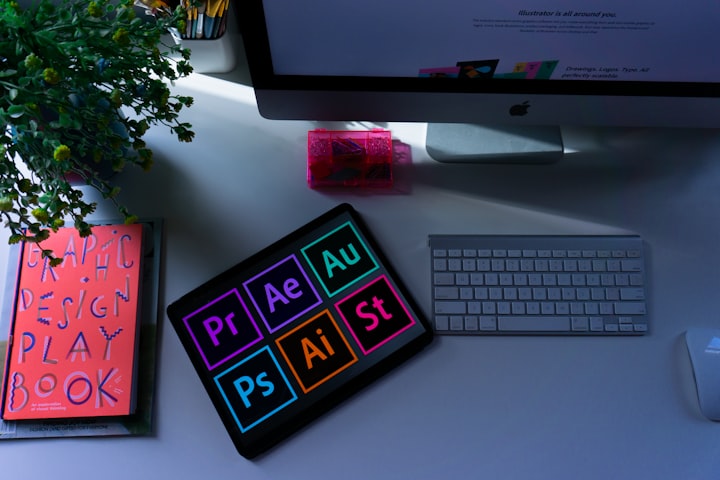Unleashing Creativity: A Look into the World of Graphic Design
graphic design , how to create , Design

Definition of graphic design:
Graphic design is the process of visual communication through the use of typography, imagery, and color. It involves the creation of visual elements, such as logos, posters, brochures, packaging, websites, and other forms of media, that are used to convey information, promote a product or service, or create a specific visual aesthetic. Graphic designers use a combination of technical skills and creative problem-solving to create effective visual solutions that meet the needs of clients and target audiences. The goal of graphic design is to make complex information accessible, and to create visually pleasing and engaging designs that are easy to understand.
Software and technology used in graphic design:
There are many software and technology tools that are used in graphic design, some of the most popular ones include:
- Adobe Creative Suite: This is a collection of software programs that are widely used in the graphic design industry. It includes programs such as Photoshop (for photo editing and manipulation), Illustrator (for vector graphics and illustrations), and InDesign (for page layout and design).
- Sketch: A vector graphics editor and digital design tool primarily used for user interface and user experience design.
- Figma: A browser-based interface design tool that enables real-time collaboration among team members.
- CorelDRAW: A vector graphics editor, layout and illustration software, used for creating illustrations, brochures, posters, logos and more.
- Affinity Designer: A vector graphics editor that also allows to work on raster graphics, logo, icon, web graphics, game graphics, print projects, mockups and more.
- Canva: An online graphic design tool that allows you to easily create visual content such as social media posts, brochures, and infographics.
- Blender: A free and open-source 3D creation software used for making animated films, video games, and visual effects.
- GIMP: A free and open-source image editing software, similar to Adobe Photoshop.
These are just a few examples of the many software and technology tools that are used in graphic design. Other tools include Inkscape, Adobe XD, QuarkXPress, Cinema 4D, and more. Graphic designers may use one or more of these tools depending on their specific design needs and preferences.
Graphic Design Specializations:
- Web Design: Specializing in the design of websites and web-based applications, this includes user interface design, user experience design, and responsive design.
- Branding and Identity Design: Specializing in the creation of visual identity systems, such as logos, typography, and color schemes, for businesses, organizations and products.
- Packaging Design: Specializing in the design of packaging for consumer products, such as food, beauty, and household items.
- Advertising Design: Specializing in the design of visual elements for advertising campaigns, such as print ads, billboards, and social media graphics.
- Motion Graphics: Specializing in the design of animation and visual effects for film, television, and digital media, this includes title sequences, visual effects, and interactive design.
- Illustration: Specializing in creating illustrations for books, magazines, advertising and other media.
- Environmental Design: Specializing in the design of public spaces, such as exhibitions, trade shows, and museums.
- User Interface (UI) Design: Specializing in the design of the visual elements of software and mobile apps, such as buttons, icons, and navigation menus.
- User Experience (UX) Design: Specializing in the design of the overall experience of using a product, including the interface, graphics, and the behavior of the product.
These are just a few examples of the many specializations within the field of graphic design. Graphic designers may choose to specialize in one or more areas depending on their interests and career goals.
The Future of Graphic Design:
The future of graphic design is constantly evolving as new technologies, trends, and innovations continue to emerge. Some of the key trends and technologies that are shaping the future of graphic design include:
- Artificial Intelligence (AI) and Machine Learning (ML): AI and ML are becoming increasingly integrated into graphic design software and tools, allowing for more efficient and automated design processes.
- Virtual and Augmented Reality (VR/AR): VR and AR are becoming more prevalent in the graphic design industry, enabling designers to create immersive and interactive experiences for users.
- Web 3.0 and the Semantic Web: With the development of Web 3.0, designers will have more opportunities to create more interactive and personalized online experiences for users.
- Responsive Design: With the increasing use of mobile devices to access the internet, designers will need to focus on creating responsive designs that adapt to different screen sizes and resolutions.
- Microinteractions: Microinteractions are small interactions that happen in the interface, like hovering over an icon, a progress bar, or a pull-to-refresh gesture. They are becoming increasingly important in graphic design as they make the experience more engaging and interactive.
- Data visualization: More and more designers are using data visualization to communicate complex information in an easy-to-understand way.
- Human-centered design: The focus on designing for the user's needs, wants, and behavior will continue to be a key trend in the future of graphic design.
- Accessibility and Inclusivity: Designers will continue to focus on making designs accessible and inclusive for people with disabilities, as well as for people with different cultural backgrounds.
These are just a few examples of the many trends and technologies that are shaping the future of graphic design. As the digital landscape continues to evolve, the field of graphic design will also continue to change and adapt to meet the needs of clients and audiences.
Conclusion:
In conclusion, graphic design is a field that is constantly evolving with new technologies, trends, and innovations. Graphic designers use a combination of technical skills and creative problem-solving to create effective visual solutions that meet the needs of clients and target audiences. The goal of graphic design is to make complex information accessible, and to create visually pleasing and engaging designs that are easy to understand. There are many specializations within the field of graphic design, such as web design, branding and identity design, packaging design, advertising design, motion graphics and more. The future of graphic design is shaped by many trends and technologies, such as Artificial Intelligence, Virtual and Augmented Reality, Responsive Design, Human-centered design, Data visualization, Microinteractions and Accessibility and Inclusivity. As the digital landscape continues to evolve, the field of graphic design will also continue to change and adapt to meet the needs of clients and audiences.





Comments
There are no comments for this story
Be the first to respond and start the conversation.